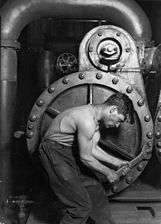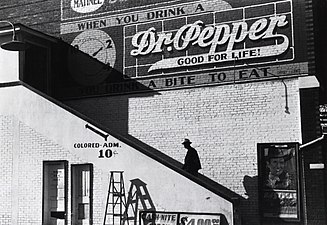Dokumentärfotografi
| Den här artikeln behöver källhänvisningar för att kunna verifieras. (2015-07) Åtgärda genom att lägga till pålitliga källor (gärna som fotnoter). Uppgifter utan källhänvisning kan ifrågasättas och tas bort utan att det behöver diskuteras på diskussionssidan. |

Dokumentärfotografi avser ett slags bildjournalistik, där fotografen försöker skapa en rimligt sanningsenlig och objektiv bild av ett särskilt motiv, som ofta är en människa eller flera. Bilderna återspeglar oftast ett av fotografen utvalt perspektiv av motivet.
Uttrycket dokumentär fotografi tillskrivs i allmänhet den amerikanske historikern Beaumont Newhall som i mars 1938 i tidskriften Parnassus publicerade en artikel med titeln "Documentary approach to photography".[1].
Bildgalleri
Sotaren John Day, London, av John Thomson omkring 1873
Bandit's Roost av Jacob Riis omkring 1890
Lumpsamlare på avenue des Gobelins i Paris 1899 av Eugène Atget
Den tolvåriga spinnerskan Addie Card, Vermont, USA, 1910 av Lewis Hine
Tåg med soldater, Ems 1914 av Julius Goebel
Power house mechanic working on steam pump av Lewis Hine 1920
Manuel Rivera-Ortiz, Tobacco Harvesting, Valle de Viñales, Kuba 2002
Fiolspelaren Bill Henseley 1937 av Ben Shahn
Segregerad biografentré på Crescent Theatre i Belzoni, Mississippi, troligen i oktober 1939, av Marion Post Wolcott
Källor
- ^ Leenhardt, Jacques (1982). ”La photographie, miroir des sciences humaines”. Communications 36 (1): sid. 107–118. doi:. ISSN 0588-8018. https://dx.doi.org/10.3406/comm.1982.1542. Läst 15 oktober 2022.
Se även
Media som används på denna webbplats
Författare/Upphovsman: Tkgd2007, Licens: CC BY-SA 3.0
A new incarnation of Image:Question_book-3.svg, which was uploaded by user AzaToth. This file is available on the English version of Wikipedia under the filename en:Image:Question book-new.svg
Lewis Hine, 1920. Power house mechanic working on steam pump.
Records of the Work Progress Administration. (69-RH-4L-2)
Lewis Hine's 1920 Power house mechanic working on steam pump, one of his "work portraits", shows a working class American in an industrial setting. The carefully posed subject, a young man with wrench in hand, is hunched over, surrounded by the machinery that defines his job. But while constrained by the machinery (almost a metal womb), the man is straining against it—muscles taut, with a determined look—in an iconic representation of masculinity.African-American patron going in colored entrance of the Crescent Theatre in Belzoni, Mississippi, on a Saturday afternoon.
The Temperance Sweep by John Thomson, published in Street Life in London, 1877
Fiddlin Bill Henseley, Mountain Fiddler, Asheville, North Carolina by Ben Shahn, 1937.
Public Domain. Suggested credit: Shahn/Library of Congress via pingnews. Additional source information:
CALL NUMBER: LC-USF33- 006258-M3 [P&P]
REPRODUCTION NUMBER: LC-USF331-006258-M3 (b&w film copy neg. from print) LC-DIG-ppmsc-00252 (digital file from print)
MEDIUM: 1 negative : nitrate ; 35 mm.
CREATED/PUBLISHED: 1937.
CREATOR:
Shahn, Ben, 1898-1969, photographer.
RELATED NAMES:
United States. Resettlement Administration.
NOTES:
Title and other information from caption card.
File print cropped and shows only Fiddlin' Bill.
LOT 1488 (Location of corresponding print.)
Transfer; United States. Office of War Information. Overseas Picture Division. Washington Division; 1944.
TOPICS:
Music festivals--North Carolina
SUBJECTS:
United States--North Carolina--Asheville.
FORMAT:
Nitrate negatives.
PART OF: Farm Security Administration - Office of War Information Photograph Collection (Library of Congress)
REPOSITORY: Library of Congress Prints and Photographs Division Washington, DC 20540 USA
DIGITAL ID: (digital file from intermediary roll film of original neg.) fsa 8a17160 (original print) ppmsc 00252
OTHER NUMBER: E 916
CARD #: fsa1997017104/PPPortrait shows Florence Thompson with several of her children in a photograph known as "Migrant Mother". The Library of Congress caption reads: "Destitute pea pickers in California. Mother of seven children. Age thirty-two. Nipomo, California." In the 1930s, the FSA employed several photographers to document the effects of the Great Depression on the population of America. Many of the photographs can also be seen as propaganda images to support the U.S. government's policy distributing support to the worst affected, poorer areas of the country. Lange's image of a supposed migrant pea picker, Florence Owens Thompson, and her family has become an icon of resilience in the face of adversity. However, it is not universally accepted that Florence Thompson was a migrant pea picker. In the book Photographing Farmworkers in California (Stanford University Press, 2004), author Richard Steven Street asserts that some scholars believe Lange's description of the print was "either vague or demonstrably inaccurate" and that Thompson was not a farmworker, but a Dust Bowl migrant. Nevertheless, if she was a "Dust Bowl migrant", she would have left a farm as most potential Dust Bowl migrants typically did and then began her life as such. Thus any potential inaccuracy is virtually irrelevant. The child to the viewer's right was Thompson's daughter, Katherine (later Katherine McIntosh), 4 years old (Leonard, Tom, "Woman whose plight defined Great Depression warns tragedy will happen again ", article, The Daily Telegraph, December 4, 2008) Lange took this photograph with a Graflex camera on large format (4"x5") negative film.[1]
1914 von dem Hoffotografen Julius Goebel gefertigte Dokumentarfotografie mit einem die Stadt Bad Ems verlassenden Eisenbahn-Zug mit verschiedenen Waggons voller Soldaten auf dem Weg in den Krieg. Hinter einer Absperrung zahlreiche Frauen, Kinder und alte Männer, die den Soldaten zum Abschied winken. Der originale Fotoabzug findet sich im Stadtmuseum Bad Ems ...
A ragpicker early in the morning in Paris, Avenue des Gobelins, Paris, 1899
TITLE: Addie Card, 12 years. Spinner in North Pormal [i.e., Pownal] Cotton Mill. Vt. Girls in mill say she is ten years. She admitted to me she was twelve; that she started during school vacation and now would "stay." E. F. Brown. See Photo #1050. Location: North Pownal, Vermont.
Bandit roost (59 Mulberry Street in New York City) this famous pic.was taken in 1888 by Jacob Riis, Jacob August Riis (/riːs/; May 3, 1849 – May 26, 1914) was a Danish-American social reformer, "muckraking" journalist, social documentary photographer
Författare/Upphovsman: Manuel Rivera-Ortiz, Licens: CC BY-SA 3.0
Tobacco Harvesting, Valle de Viñales, Cuba, 2002. (Photo by Manuel Rivera-Ortiz; used with permission of author). Description by Rivera-Ortiz (used with permission of author): "A family of six grows tobacco in their farm which ends up in government warehouses to be shipped as cigars around the world. The family receives very little for their backbreaking work, with the rest of the profits from the sales of cigars going to government coffers for island-wide social programs. About 50,000 hectares (123,550 acres, or, 2.471 acres per hactare) are reserved for growing tobacco in Cuba. Tobacco is predominantly grown in the 90-mile-long (10-mile-wide) valley Vuelta Abajo, Pinar del Rio, where this photo was taken, at the foot of these limestone hills fraught with natural caves and tunnels which were once inhabited by Pre-Columbian Indians and later, by runaway slaves. In 1999, Altadis, a Franco-Spanish tobacco giant, is said to have signed a $500 million USD deal to take over a 50% stake in Cuba’s state owned firm Habanos S.A."


















